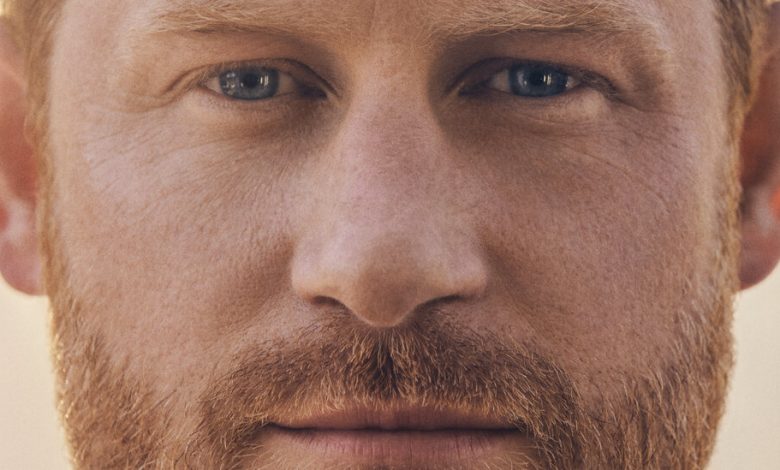Prince Harry, Up Close

He stares out, his blue eyes unflinching beneath scruffy red brows. His head, with its matching rough-cut hair and beard, almost fills the frame. You can see, just at the bottom edge, a faded gray T-shirt and leather thong necklace.
Prince Harry’s portrait on the front of “Spare,” his much debated, much leaked memoir that is currently also pretty much unavoidable, is a picture that its publishers hope will help sell a million-plus books. Sure, all the juicy gossip about what’s inside makes a difference. But when it comes to the emotional pull that makes a book into an object of desire and curiosity, a promise of payoff to come, the image matters.
It creates a host of subconscious assumptions in the blink of an eye about what readers might find once they crack the cover. It is to the words inside as a gorgeous perfume bottle is to its scent: the substantiation of the contents.
And when it comes to Harry’s cover, it is as much about what it isn’t as what it is.
It is not, for example, remotely royal. The pomp and circumstance paid for by the British people is in no way present. Harry’s split with the monarchy is preserved for all to see. There is no crown. No robe. No military dress. Not even a Savile Row suit.
If Harry is bidding to position himself, like his mother before him, as the people’s prince, this is his heraldic banner. That is, after all, the premise of the book — that is, a portrait created, he said, not as “the prince I was born but as the man I have become.”
More on the British Royal Family
- Harry vs. William: In the latest installment of the Netflix documentary “Harry & Meghan,” Harry made several incendiary allegations about his brother, William.
- Aide Resigns: Two weeks after she was pressed repeatedly by a royal household member about which country she came from, a British-born Black woman returned to Buckingham Palace to receive a face-to-face apology from her interrogator.
- Boston Visit: Prince William and Princess Catherine of Wales recently made a whirlwind visit to Boston. Swaths of the city were unimpressed.
- ‘The Crown’: Months ago, the new season of the Netflix drama was shaping up as another public-relations headache for Prince Charles. But then he became king.
So there he is: the man he has become. For all to see.
The photo positions Harry in the most accessible, uncostumed way possible, which is, of course, a kind of costume in itself — just like us, as opposed to just like his family. It is different from King Charles’s recent biography, “The King: The Life of Charles III,” which captures the king in a double-breasted suit and striped tie, pocket hankie at the ready, or even the most recent Harry and Meghan book, “Finding Freedom,” which depicted the prince in a dove-gray suit alongside his wife. Rather, on his own book cover, Harry is stripped, if not bare, as close to it as is appropriately possible.
His face is unadorned, save for his beard, which we now know, thanks to his ITV interview with the British journalist Tom Bradby, was the source of brotherly strife, but which was important because, Harry said, it represented “the new Harry.” The only decorative element is the leather necklace, which given the revelation that William pushed Harry down during a tiff in Nottingham Cottage and ripped his necklace, suddenly seems like an Easter egg, freighted with symbolism.
Harry is not smiling, not gazing off into the sunset or the future or the heavens, not contemplating his own inner thoughts, like many such photos on other recent best-selling memoirs, be it Michelle Obama’s “Becoming,” Barack Obama’s “A Promised Land” or Edward Enninful’s “A Visible Man” (though, as Matthew Dorfman, the art director of The New York Times Book Review, pointed out, the simplicity of the typography reflects a similar straightforward design). Instead, Harry seems to be fully present, with no scrim between himself and the reader. The impression is one of immediacy. Of nothing to hide.
Given the speculation that he considered softening the tone of the memoir after the death of Queen Elizabeth II, the look serves as a counter-thrust: a visual implication that what is inside will be equally unfiltered.
Harry is not, of course, the first memoirist to use this strategy. Piers Morgan derisively compared the “Spare” cover to that of Andre Agassi’s 2009 book, “Open,” also ghostwritten by J.R. Moehringer, who worked with Harry, and also featuring the subject’s head front and center, full-bleed, on the cover. Mr. Morgan was correct in noting the similarity but wrong in seeing that as a failing. It’s a calculated choice, placing the memoir in the tradition of books noted for their honesty, rather than their airbrushing of history.
In any case, the photographer is different. Harry was captured by Ramona Rosales, who is known for her work with celebrities like Oprah Winfrey, John Legend, and Hillary and Chelsea Clinton, and who recently photographed Meghan for the cover of Variety. Opting for Ms. Rosales as his portraitist was a pledge of further allegiance by Harry to America, inclusivity and the new life he and his wife claim to have made.
So much to read, with almost no words at all.
